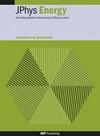液晶基软材料中的热效应
IF 6.3
3区 材料科学
Q1 ENERGY & FUELS
引用次数: 0
摘要
随着环保意识的提高,寻找更环保的热管理技术已成为许多科学研究的主题。具有大热效应的热材料,如电热(EC)和弹性热(EC)效应,由于其实现新型固态制冷设备的潜力,人们对其越来越感兴趣。近年来,在这些材料中观察到的大热量效应的刺激下,液晶(LC)和LC弹性体(LCE)等软材料的热性能越来越成为热材料研究的焦点。本文概述了近晶LC14CB和主链LCE中大热量效应的最新直接测量结果。具体而言,高分辨率测温测量显示,14CB LC的EC响应超过8 K。与固体EC材料相比,在30 kV cm−1的相对中等电场下获得了如此大的效应。我们证明,这样一个小的场可以在14CB中诱导各向同性到近晶a的相变,释放或吸收相对较大的潜热,从而增强EC响应。此外,研究表明,在主链LCE中,通过降低交联剂的密度,可以将向列向各向同性转变的特性从超临界状态调整为一阶状态。这种调谐导致更尖锐的相变和潜热,增强了eC响应,超过2 K,eC响应度为24 K MPa−1,比最佳形状记忆合金中的平均eC响应率大约三个数量级。在软LC基材料中观察到的显著的热效应,在比固体热材料小得多的场下观察到,证明了它们在新的热管理设备中作为新的冷却元件、热二极管和热活性再生材料发挥重要作用的能力。本文章由计算机程序翻译,如有差异,请以英文原文为准。
Caloric effects in liquid crystal-based soft materials
With the increased environmental awareness, the search for environmentally friendlier heat-management techniques has been the topic of many scientific studies. The caloric materials with large caloric effects, such as the electrocaloric (EC) and elastocaloric (eC) effects, have increased interest due to their potential to realize new solid-state refrigeration devices. Recently, caloric properties of soft materials, such as liquid crystals (LCs) and LC elastomers (LCEs), are getting more in the focus of caloric materials investigations, stimulated by large caloric effects observed in these materials. Here, an overview of recent direct measurements of large caloric effects in smectic LC 14CB and main-chain LCEs is given. Specifically, high-resolution thermometric measurements revealed a large EC response in 14CB LC exceeding 8 K. Such a large effect was obtained at a relatively moderate electric field of 30 kV cm−1 compared to solid EC materials. We demonstrate that such a small field can induce the isotropic to smectic A phase transition in 14CB, releasing or absorbing relatively large latent heat that enhances the EC response. Furthermore, it is demonstrated that in main-chain LCEs, the character of the nematic to isotropic transition can be tuned from the supercritical towards the first-order regime by decreasing the crosslinkers’ density. Such tuning results in a sharper phase transition and latent heat that enhance the eC response, exceeding 2 K and with the eC responsivity of 24 K MPa−1, about three orders of magnitude larger than the average eC responsivity found in the best shape memory alloys. Significant caloric effects in soft LC-based materials, observed at much smaller fields than in solid caloric materials, demonstrate their ability to play an important role as new cooling elements, thermal diodes, and caloric-active regeneration material in new heat-management devices.
求助全文
通过发布文献求助,成功后即可免费获取论文全文。
去求助
来源期刊

Journal of Physics-Energy
Multiple-
CiteScore
10.90
自引率
1.40%
发文量
58
期刊介绍:
The Journal of Physics-Energy is an interdisciplinary and fully open-access publication dedicated to setting the agenda for the identification and dissemination of the most exciting and significant advancements in all realms of energy-related research. Committed to the principles of open science, JPhys Energy is designed to maximize the exchange of knowledge between both established and emerging communities, thereby fostering a collaborative and inclusive environment for the advancement of energy research.
 求助内容:
求助内容: 应助结果提醒方式:
应助结果提醒方式:


